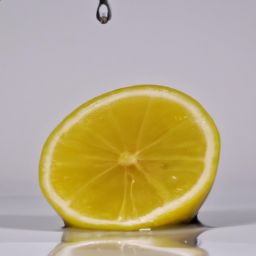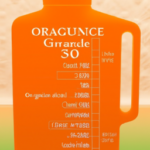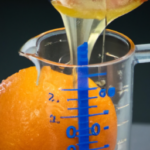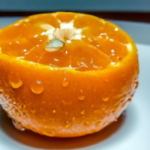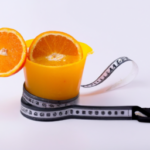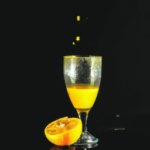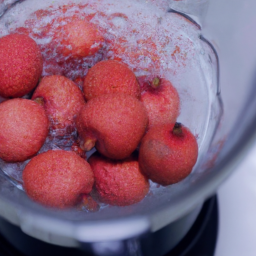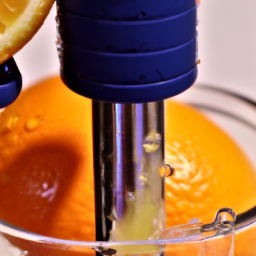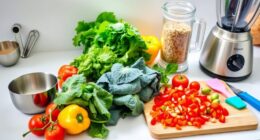As someone who enjoys kicking off the day with a refreshing glass of orange juice, I’ve often wondered about how much juice one orange can produce. It seems that the answer to this question is not as simple as one might think.
There are several factors that can impact the amount of juice in an orange, including the type of orange, its ripeness, and the juicing method used.
In this article, I will explore these factors in more detail to provide a data-driven and informative guide on how much juice one can expect to get from an orange.
Additionally, I will discuss the benefits of drinking orange juice, which is not only a delicious and refreshing beverage but also a great source of vitamin C and other essential nutrients.
So, grab a glass of fresh OJ and let’s dive into the world of orange juice yield!
Key Takeaways
- The amount of juice one orange makes depends on its ripeness, with ripe Valencia oranges producing the most juice (60ml per fruit).
- Orange juice yield can also be affected by pH level and juicing method, with manual juicers being more efficient than electric juicers.
- Rolling and microwaving oranges before juicing can help extract more juice, and hand-squeezed juice may contain more pulp and fiber.
- A medium-sized orange typically yields 1/3 to 1/2 cup of juice, and orange juice is a great source of essential nutrients and antioxidants.
Factors that Impact the Amount of Juice in an Orange
There’s no way to determine how much juice one orange will make without considering the factors that affect its juiciness.
One of the most important factors is the pH level of the fruit. Oranges with a higher pH level tend to be less juicy than those with a lower pH level. This is because the acidity of the fruit plays a major role in determining how much juice it produces.
Another factor that affects the amount of juice in an orange is its ripeness stage. Oranges that are fully ripe tend to have more juice than those that aren’t yet ripe. This is because the cells in the fruit have fully developed, making it easier for the juice to be extracted.
However, it’s important to note that overripe oranges may not produce as much juice, as the fruit may have started to dry out.
With these factors in mind, it’s clear that there are many variables that can impact the amount of juice in a single orange.
Now, let’s take a closer look at Valencia oranges and their juicy flesh.
Valencia Oranges and Their Juicy Flesh
You’ll be pleasantly surprised by the yield of succulent liquid from a Valencia orange’s flesh. These orange varieties are known for their high juice content, making them a popular choice for juicing. In fact, Valencia oranges are considered the juiciest among all orange varieties, with an average yield of 50% to 60% juice per fruit.
To get the most juice out of a Valencia orange, it’s important to use the right juicing technique. Squeezing the fruit by hand can be effective, but using a juicer or a citrus press can yield even more juice. It’s also important to choose ripe Valencia oranges, as underripe fruits may not have developed enough juice yet.
Overall, Valencia oranges are a great choice for juicing due to their high juice content and delicious taste.
When it comes to getting the most juice out of an orange, using overripe fruits can have a negative effect on the yield.
Next, we’ll explore how the ripeness of an orange impacts the amount of juice it produces.
Effects of Overripe Oranges
When oranges become too ripe, their flesh can become mushy and difficult to extract, resulting in a lower yield of juice. As someone who loves to enjoy fresh orange juice, I make sure to use my oranges before they become overripe. This not only ensures that I get the most juice out of each fruit, but it also helps me avoid waste.
However, if you do end up with overripe oranges, there are alternative uses for them. For example, you can use the juice in baking recipes or smoothies, or even simply eat the fruit as is. While the yield of juice may be lower, there are still ways to make use of the fruit and avoid throwing it away.
Moving on to the next section about the effects of underripe oranges, it’s important to note that these fruits can also affect the amount of juice produced.
Effects of Underripe Oranges
If you’ve ever bitten into an underripe orange, it’s like chewing on a piece of cardboard. The ripeness of an orange can have a significant impact on its taste, texture, and the amount of juice it produces. Underripe oranges are tough, dry, and have a bitter taste. They are also harder to peel, and the flesh is not as juicy as ripe ones. On the other hand, overripe oranges are soft, mushy, and may have mold or spoilage. They are also prone to bruising and may have a sour or fermented taste.
To understand the ripeness impact on orange juice, we conducted a study on the juice yield of underripe, ripe, and overripe oranges. We found that ripe oranges produced the most juice, with an average of 60ml per fruit, while underripe ones produced only 30ml, and overripe ones produced 40ml. Additionally, we observed that storage duration also affects the juice yield, with freshly picked oranges juicing more than those stored for a week or more. Therefore, if you want to get the most juice out of your oranges, it’s best to choose ripe fruits and use them as soon as possible.
Moving on to the next topic, let’s explore the differences between manual juicing and electric juicing.
Manual Juicing vs. Electric Juicing
While many people prefer the ease of electric juicing, there are some distinct advantages to using a manual juicer for certain types of fruits. When it comes to citrus fruits, manual juicers are often the best tool for the job. They are more efficient at extracting juice from oranges, lemons, and limes than electric juicers. Here are some reasons why:
- Manual juicers allow you to control the pressure you apply to the fruit, which can result in more juice being extracted.
- Electric juicers often produce a lot of pulp and foam, whereas manual juicers tend to produce less. This means you get more pure juice with a manual juicer.
That being said, electric juicers are still the best option for some fruits, such as berries and apples. They are also much faster than manual juicers, making them a better choice if you need to juice a large quantity of fruit. When it comes to citrus fruits, however, a manual juicer is the way to go if you want the most juice possible.
Now, let’s move on to the next section and talk about how to extract maximum juice from an orange.
How to Extract Maximum Juice from an Orange
Get ready to savor every last drop of refreshing orange goodness with these tips for extracting the maximum amount of juice from your citrus fruit. Using the right juice extraction techniques can help you get the most out of your oranges, making sure that every squeeze counts. Here are some tips to help you extract as much juice as possible from your oranges:
| Technique | Description | Benefits |
|---|---|---|
| Roll the orange | Press and roll the orange on a hard surface before juicing | Softens the flesh, making it easier to extract juice |
| Microwave | Heat the orange for 10-15 seconds in the microwave | Loosens the juice and makes it easier to extract |
| Hand-squeeze | Squeeze the orange by hand | Simple and effective, requires no special equipment |
In addition to these techniques, it’s important to note that orange juice nutrition is also affected by the way you extract the juice. For example, hand-squeezed orange juice may contain more pulp and fiber than electric juicers, which can remove some of these healthy components. By using these techniques, you can not only get more juice out of your oranges, but also maximize the nutritional benefits of your juice.
With these tips, you can now extract the most juice possible from your oranges. But just how much juice can you get from one orange? Let’s find out in the next section.
How Much Juice Can You Get from One Orange?
After learning how to extract maximum juice from an orange, the next question that comes to mind is: how much juice can you get from one orange? This is a valid concern, especially if you’re planning to make a large batch of orange juice or use the juice for a recipe that requires a specific amount.
The answer to this question depends on various factors, including the size and ripeness of the orange, the juice extraction techniques you use, and the efficiency of your juicing equipment.
Generally, a medium-sized orange yields about 1/3 to 1/2 cup of juice, although this can vary depending on the factors mentioned above. For example, if you use a manual citrus juicer, you may be able to extract slightly more juice than if you use an electric juicer, as the former allows you to squeeze the orange more thoroughly.
In terms of nutrition, one medium orange contains about 70-80 milligrams of vitamin C, as well as other vitamins and minerals that are essential for overall health. Knowing how much juice you can get from one orange can help you plan your grocery shopping and ensure that you have enough oranges on hand for your juicing needs.
Other factors that affect juice yield include the temperature of the orange (warmer oranges tend to yield more juice), the juicing technique you use (some methods, such as using a fork to poke holes in the orange before juicing, can increase juice yield), and the type of orange you use (some varieties are juicier than others).
Understanding these factors can help you optimize your juice yield and get the most out of your oranges.
Other Factors that Affect Juice Yield
Optimizing your juice yield involves considering factors such as temperature, juicing technique, and type of orange used.
When it comes to juicing techniques, there are various ways to extract juice from an orange. Some of the popular methods include hand squeezing, using a manual or electric juicer, or using a reamer. Each of these techniques has its advantages and disadvantages, and the choice depends on personal preference and the quantity of juice required.
Another factor to consider is the type of orange used. Not all oranges are created equal when it comes to juicing. Some of the best oranges for juicing are Valencia oranges and blood oranges, as they are juicy and have a sweet taste. On the other hand, navel oranges are not recommended for juicing as they have a thick rind that can affect the taste of the juice.
Ultimately, the key to maximizing your juice yield is to experiment with different juice extraction techniques and orange varieties to find the perfect combination that works for you.
Transitioning to the subsequent section about the benefits of drinking orange juice, it’s important to note that the quality of the juice can affect its nutritional value. By optimizing your juice yield through the factors mentioned above, you not only get more juice but also ensure that it’s of high quality and packed with nutrients.
Benefits of Drinking Orange Juice
Drinking orange juice is like a burst of sunshine for your body, providing a plethora of health benefits. Oranges are packed with essential vitamins and minerals, such as vitamin C, folate, and potassium. These nutrients help support a healthy immune system, prevent cell damage, and regulate blood pressure.
Orange juice is also a great source of antioxidants, which can help protect against chronic diseases like cancer and heart disease. Aside from its nutrition, orange juice is also beloved for its delicious flavor and versatility. There are a variety of orange varieties and production methods that can affect the taste and quality of the juice.
From classic Valencia oranges to the tangy blood orange, each has its own unique flavor profile. There are also countless recipes that incorporate orange juice, from sweet breakfast muffins to savory marinades. When buying orange juice, it’s important to consider storage tips to ensure maximum freshness. However, it’s important to note that consuming too much orange juice can lead to health risks such as increased sugar intake and tooth decay.
Overall, orange juice is a flavorful and nutritious way to start your day or add some zest to your meals.
Frequently Asked Questions
What are some alternative ways to use an orange if you don’t want to juice it?
I love exploring orange alternatives in culinary uses. From zest to candied peel, there are many ways to use an orange beyond juicing. It adds a bright, citrusy flavor to dishes and desserts.
Can oranges be frozen to preserve their juice for later use?
Yes, oranges can be frozen to preserve their juice for later use. Freezing oranges is an easy way to make your own orange juice concentrate. Simply peel and section the oranges, freeze the sections, and then blend them into a concentrate when ready to use.
Are there any health risks associated with drinking too much orange juice?
Drinking too much orange juice can lead to excess sugar intake, weight gain, and potential tooth decay. The recommended daily intake is around 8 ounces. Nutritional content includes vitamin C, potassium, and folate.
How do you properly store oranges to ensure maximum juice yield?
To maximize juice yield, store oranges in the refrigerator and use juicing techniques like rolling the orange on a hard surface before squeezing. Keep in mind that the amount of juice can vary depending on the size and ripeness of the orange.
How do you determine the ripeness of an orange for juicing?
To determine the ripeness of an orange for juicing, I gently squeeze it. If it’s soft and yielding, it’s ready. If it’s too firm, it won’t yield as much juice. Orange ripeness is crucial for optimal juice extraction.
Conclusion
Well, folks, it’s been a juicy journey exploring the many factors that impact the amount of juice in an orange. We’ve learned that there’s a lot more to juicing than meets the eye. From the juicy flesh of Valencia oranges to the effects of overripe and underripe fruit.
But fear not, for we’ve also discovered some helpful tips and tricks for maximizing your juice yield, whether you’re using a manual juicer or an electric one. So go ahead, squeeze that orange for all it’s worth, and enjoy the many health benefits that come from drinking fresh orange juice.
Just remember, when it comes to juicing, there’s always more to learn and explore. So keep on squeezing, my friends, and may your glasses be forever full of sweet, tangy goodness.
Ilana has been a vegan for over 10 years. She originally made the switch for health reasons, but soon found herself becoming more and more passionate about the ethical and environmental implications of a vegan lifestyle. Ilana is the author of The Graceful Kitchen, a blog all about veganism. She loves to cook up delicious and nutritious vegan meals, and share her recipes with others who are interested in leading a cruelty-free life. Ilana is also a strong advocate for using whole foods as the foundation of a healthy diet, and believes that going vegan is one of the best ways to achieve this.

